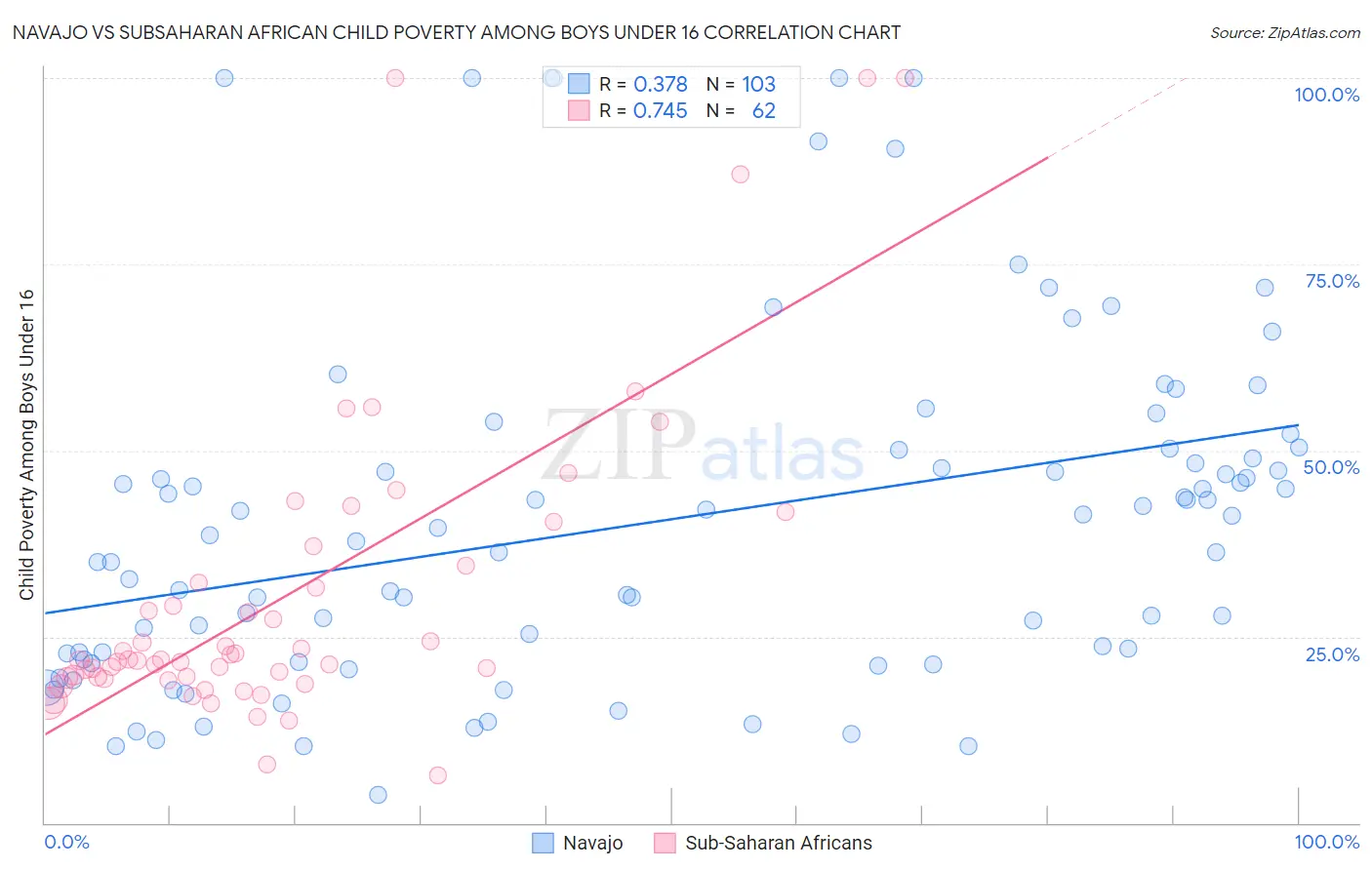Navajo vs Subsaharan African Child Poverty Among Boys Under 16
COMPARE
Navajo
Subsaharan African
Child Poverty Among Boys Under 16
Child Poverty Among Boys Under 16 Comparison
Navajo
Sub-Saharan Africans
30.3%
CHILD POVERTY AMONG BOYS UNDER 16
0.0/ 100
METRIC RATING
343rd/ 347
METRIC RANK
20.0%
CHILD POVERTY AMONG BOYS UNDER 16
0.0/ 100
METRIC RATING
276th/ 347
METRIC RANK
Navajo vs Subsaharan African Child Poverty Among Boys Under 16 Correlation Chart
The statistical analysis conducted on geographies consisting of 223,444,505 people shows a mild positive correlation between the proportion of Navajo and poverty level among boys under the age of 16 in the United States with a correlation coefficient (R) of 0.378 and weighted average of 30.3%. Similarly, the statistical analysis conducted on geographies consisting of 497,613,414 people shows a strong positive correlation between the proportion of Sub-Saharan Africans and poverty level among boys under the age of 16 in the United States with a correlation coefficient (R) of 0.745 and weighted average of 20.0%, a difference of 51.6%.

Child Poverty Among Boys Under 16 Correlation Summary
| Measurement | Navajo | Subsaharan African |
| Minimum | 3.7% | 6.5% |
| Maximum | 100.0% | 100.0% |
| Range | 96.3% | 93.5% |
| Mean | 40.5% | 30.6% |
| Median | 38.7% | 21.9% |
| Interquartile 25% (IQ1) | 22.0% | 19.4% |
| Interquartile 75% (IQ3) | 50.2% | 34.6% |
| Interquartile Range (IQR) | 28.1% | 15.2% |
| Standard Deviation (Sample) | 23.4% | 21.0% |
| Standard Deviation (Population) | 23.3% | 20.8% |
Similar Demographics by Child Poverty Among Boys Under 16
Demographics Similar to Navajo by Child Poverty Among Boys Under 16
In terms of child poverty among boys under 16, the demographic groups most similar to Navajo are Yuman (30.6%, a difference of 1.2%), Pima (29.7%, a difference of 1.8%), Tohono O'odham (31.6%, a difference of 4.2%), Immigrants from Yemen (28.9%, a difference of 5.0%), and Lumbee (31.9%, a difference of 5.4%).
| Demographics | Rating | Rank | Child Poverty Among Boys Under 16 |
| Apache | 0.0 /100 | #333 | Tragic 24.5% |
| Blacks/African Americans | 0.0 /100 | #334 | Tragic 24.5% |
| Yup'ik | 0.0 /100 | #335 | Tragic 24.7% |
| Sioux | 0.0 /100 | #336 | Tragic 25.3% |
| Cheyenne | 0.0 /100 | #337 | Tragic 25.8% |
| Hopi | 0.0 /100 | #338 | Tragic 25.9% |
| Houma | 0.0 /100 | #339 | Tragic 26.2% |
| Crow | 0.0 /100 | #340 | Tragic 26.3% |
| Immigrants | Yemen | 0.0 /100 | #341 | Tragic 28.9% |
| Pima | 0.0 /100 | #342 | Tragic 29.7% |
| Navajo | 0.0 /100 | #343 | Tragic 30.3% |
| Yuman | 0.0 /100 | #344 | Tragic 30.6% |
| Tohono O'odham | 0.0 /100 | #345 | Tragic 31.6% |
| Lumbee | 0.0 /100 | #346 | Tragic 31.9% |
| Puerto Ricans | 0.0 /100 | #347 | Tragic 32.8% |
Demographics Similar to Sub-Saharan Africans by Child Poverty Among Boys Under 16
In terms of child poverty among boys under 16, the demographic groups most similar to Sub-Saharan Africans are Immigrants from Barbados (20.0%, a difference of 0.10%), Immigrants from West Indies (20.0%, a difference of 0.12%), Jamaican (20.0%, a difference of 0.17%), Bangladeshi (20.0%, a difference of 0.25%), and Immigrants from Bangladesh (19.9%, a difference of 0.29%).
| Demographics | Rating | Rank | Child Poverty Among Boys Under 16 |
| Immigrants | Cabo Verde | 0.1 /100 | #269 | Tragic 19.7% |
| Cherokee | 0.1 /100 | #270 | Tragic 19.7% |
| Chickasaw | 0.1 /100 | #271 | Tragic 19.8% |
| Immigrants | Ecuador | 0.1 /100 | #272 | Tragic 19.8% |
| Belizeans | 0.1 /100 | #273 | Tragic 19.9% |
| Immigrants | Bangladesh | 0.0 /100 | #274 | Tragic 19.9% |
| Jamaicans | 0.0 /100 | #275 | Tragic 20.0% |
| Sub-Saharan Africans | 0.0 /100 | #276 | Tragic 20.0% |
| Immigrants | Barbados | 0.0 /100 | #277 | Tragic 20.0% |
| Immigrants | West Indies | 0.0 /100 | #278 | Tragic 20.0% |
| Bangladeshis | 0.0 /100 | #279 | Tragic 20.0% |
| Central Americans | 0.0 /100 | #280 | Tragic 20.1% |
| Immigrants | Zaire | 0.0 /100 | #281 | Tragic 20.1% |
| Comanche | 0.0 /100 | #282 | Tragic 20.1% |
| Immigrants | Jamaica | 0.0 /100 | #283 | Tragic 20.1% |